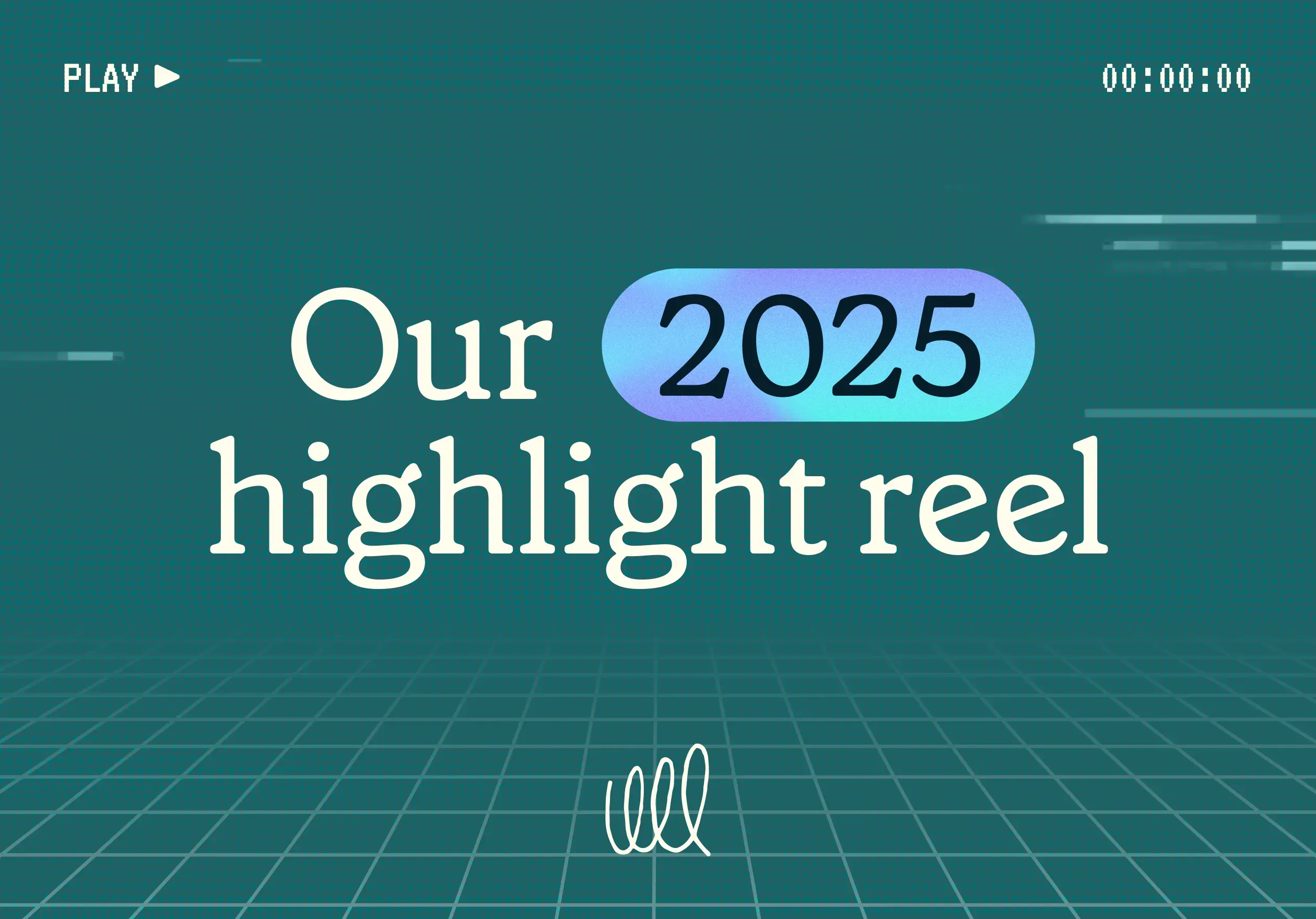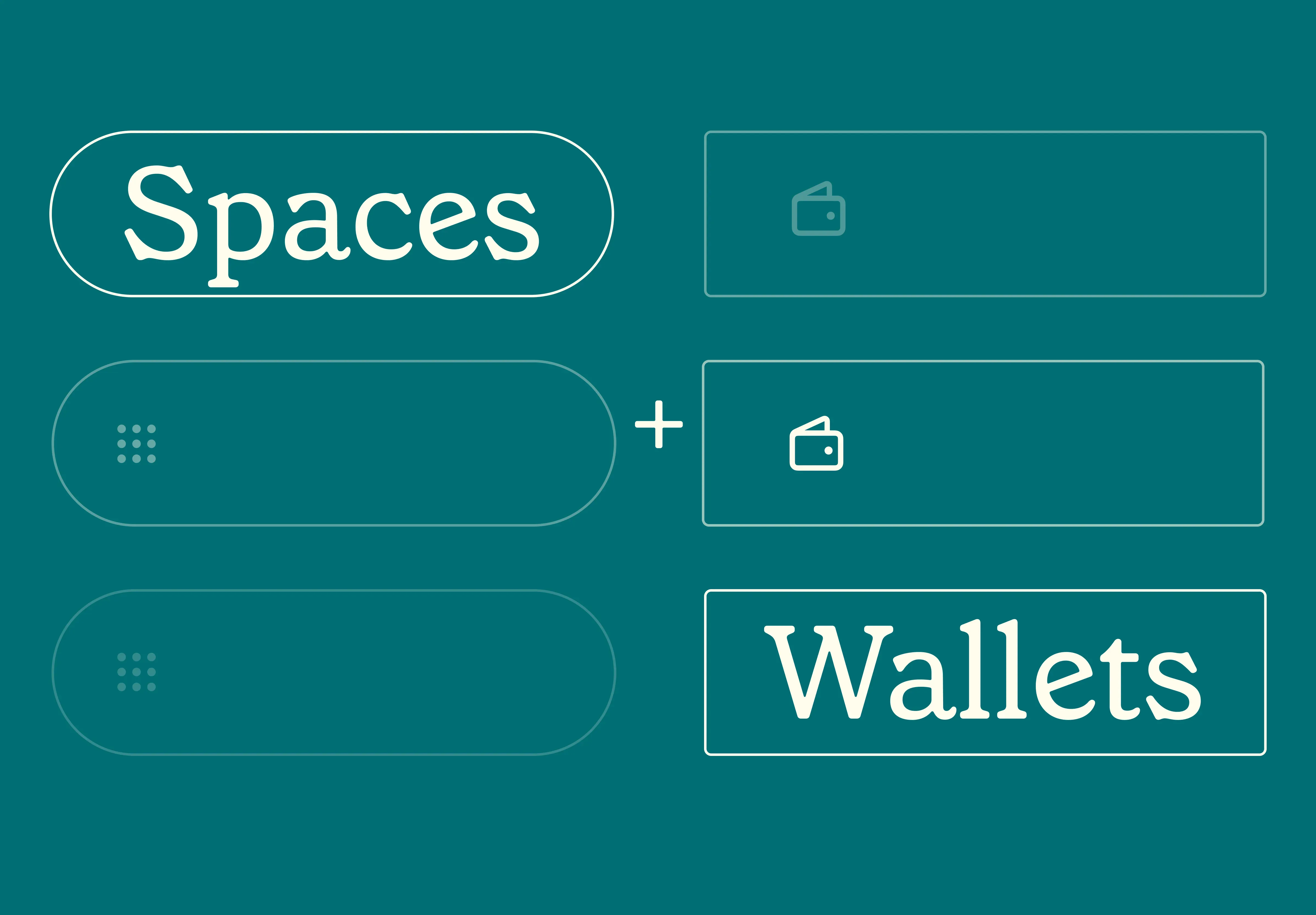14 Nov 2025
|9 min
Why is UX research an important step in the product development life cycle?
Discover how UX research is a must for creating products users love, from concept to launch. Get insider tips from Kelly Jura of ScreenPal on making every stage of development user-centered.

Building a product that users love goes beyond brilliant ideas, beautiful designs, and cutting-edge technology. It requires a deep understanding of the user's needs, behaviors, expectations, and pain points. For a product to succeed, it needs to strike the perfect balance of something that looks good and serves a real purpose. This is where UX research enters the conversation and can make an incredible impact at every stage of the product development process.
According to Kelly Jura, VP of Brand and UX Design and Research at ScreenPal, "When people work in the dark and lack user insights, they may create beautifully designed and cool products, but if the products do not fulfil a user need, they will not be adopted.”
With over 20 years of experience across various industries, Kelly shared with us why UX research is a must throughout the product life cycle and how to include it at every stage.
Why is UX research an important step in the product development life cycle?
While there are plenty of reasons why UX research is important, we’ve focused on the top four specific to the product life cycle.
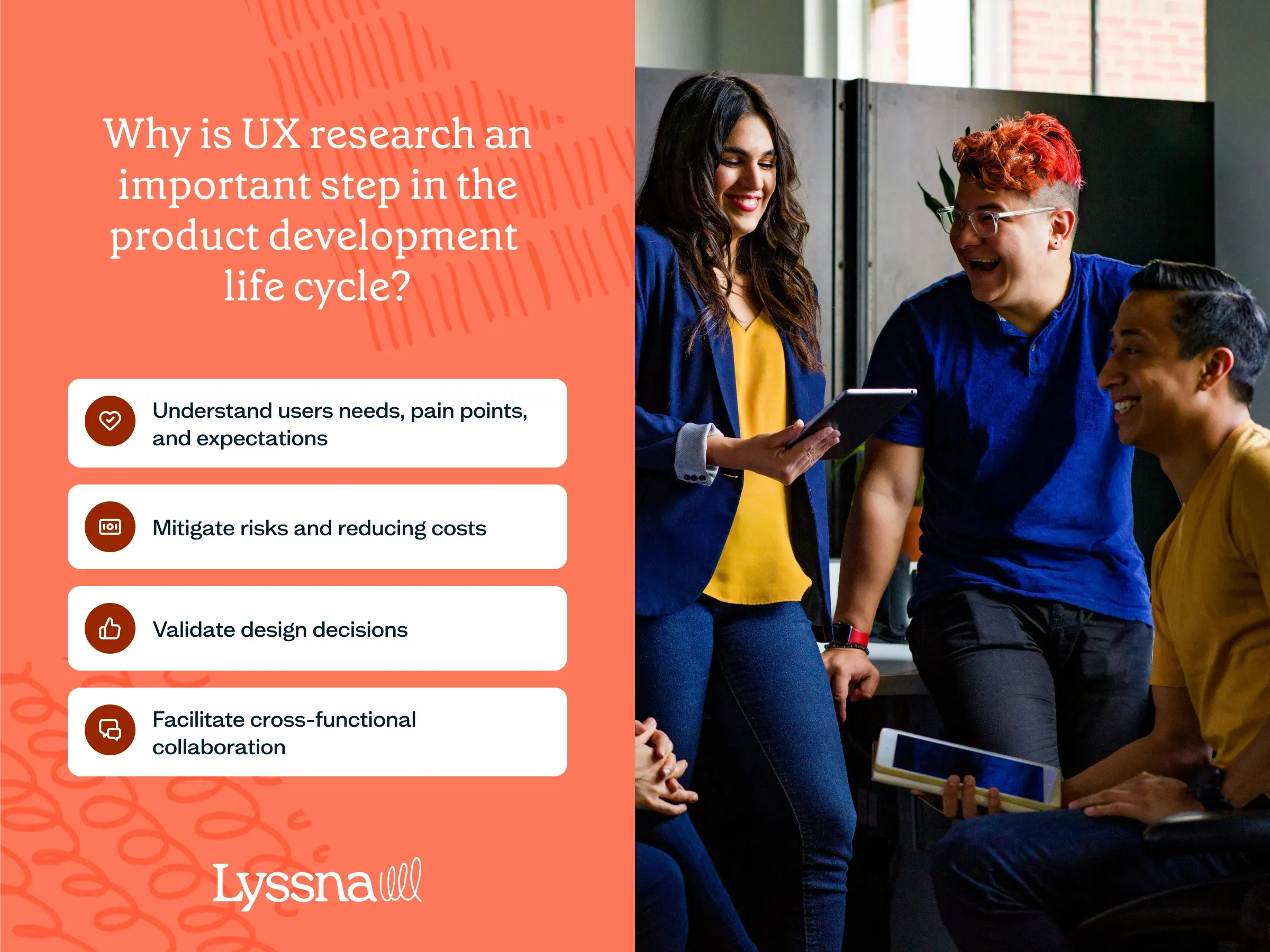
1. Understand users needs, pain points, and expectations
The core of UX research is about empathy. It's about understanding users, their challenges, and what they expect from a product. By prioritizing time and resources to dive deeper into your users during the product development process, you can make sure the product isn't just a solution looking for a problem but a real, user-centered solution.
Kelly emphasizes that when companies invest in understanding their users, they can “reduce development costs by improving the usability of the product and building features that people at the end of the day really want and need.”
Ultimately, if there’s one key takeaway, it should be this: if you want your product to hit the mark, understanding your users is key.
2. Mitigate risks and reducing costs
Product development can be risky. However, UX research helps mitigate these risks by helping you create data-driven insights to inform decision-making. By validating ideas and designs early in the process, you can avoid costly mistakes down the line.
As Kelly notes, “When you invest in assumptions around what people want or need, you could get lucky. But more than likely, you'll end up really just spinning and reworking your solution over and over again.”
UX research allows companies to be proactive rather than reactive, reducing the chances of expensive redesigns or product failures. This not only saves money but also ensures that the product development strategy is more efficient and streamlined.
3. Validate design decisions
Your designs should be supported by research, making sure they align with what your target audience wants and expects.
There are many elements to test throughout the product development process. For example, Kelly shares that her team at ScreenPal was able to “touch every single piece of our experience” during a major product rebranding and relaunch.
“To align with this kind of brand evolution that we were having, we looked at tone of voice, our internal training programs for our own employees, and we changed the way that we support our customers. We also had this really orchestrated effort to re-release our mobile apps, our desktop software, our Chrome extension, and our web platform.”
This effort allowed Kelly and the team to refresh the entire experience, identify pain points, and find opportunities for improvement.
4. Facilitate cross-functional collaboration
Product development is naturally a team effort, involving teams from design, development, and marketing. UX research acts as a bridge between these teams, by making sure the focus stays on the user and their needs.
“The more that companies can create an environment where there's collaboration between teams and there's intelligence sharing across departments, the better,” shares Kelly.
This collaborative approach makes sure that insights from UX research are integrated throughout the product development process, leading to more cohesive and successful products.
Your go-to user research platform
The best teams use Lyssna so they can deeply understand their audience and move in the right direction — faster.
The role of UX research throughout the product development life cycle
The product development life cycle is a complex process with multiple stages, each of which can benefit from UX research, especially as your organization progresses along the UX maturity model, gaining deeper insights and structure around user-centered practices. By integrating UX research into each stage, you can ensure that their products are user-centered from start to finish. Let’s walk through them now.
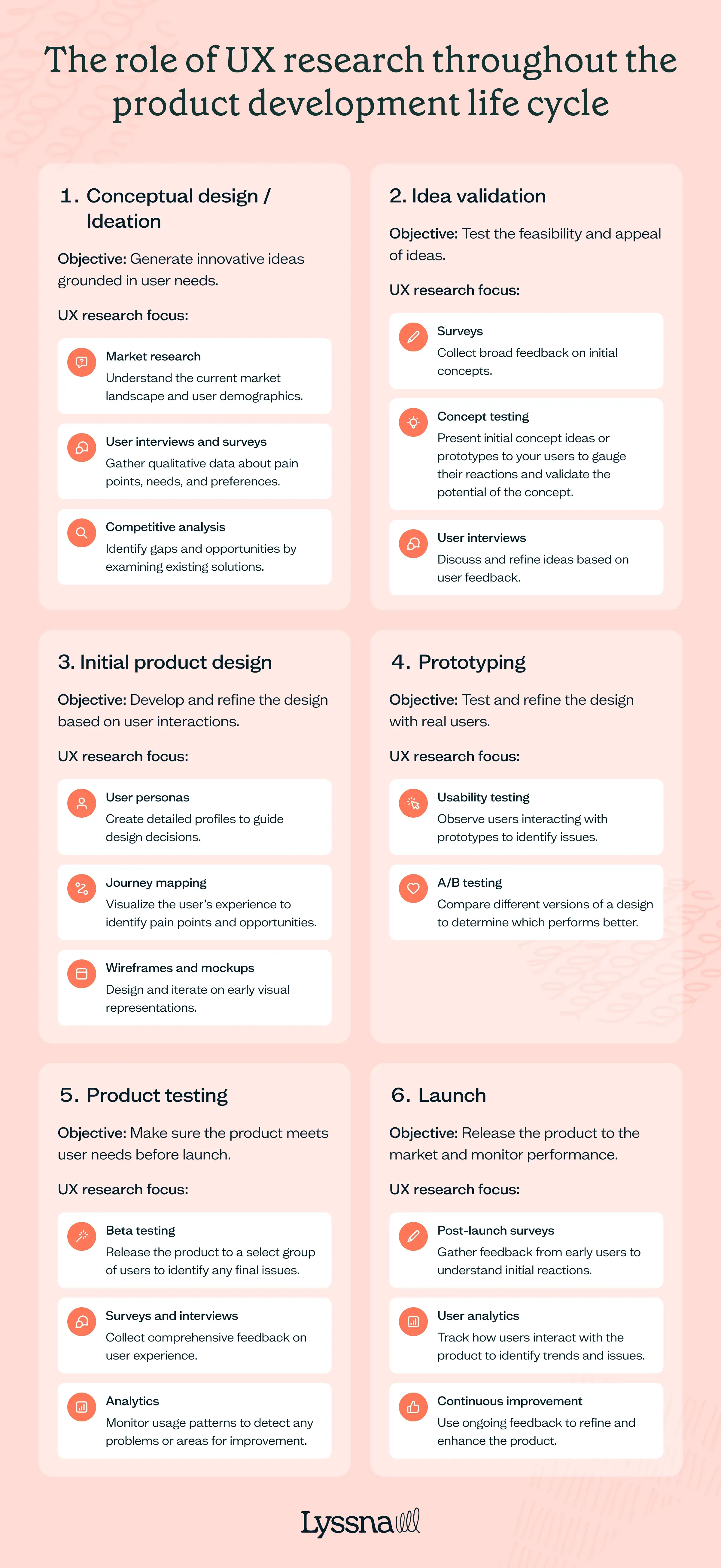
1. Conceptual design / Ideation
This is where the core idea of the product is born. During this stage, UX research and design help shape the concept by focusing on the user's needs, pain points, and desires.
Objective: Generate innovative ideas grounded in user needs.
UX research focus:
Market research: Understand the current market landscape and user demographics.
User interviews and surveys: Gather qualitative data about pain points, needs, and preferences.
Competitive analysis: Identify gaps and opportunities by examining existing solutions.
By starting with a strong foundation of user feedback, you can ensure that their ideas are relevant and valuable.
See how the British Red Cross conducted concept and desirability testing for new fundraising product ideas.
2. Idea validation
Once you’ve generated ideas, the next step is to test the viability of those ideas with real users. Kelly emphasizes the value of early testing, sharing that “feedback is a gift.”
By validating ideas early, you can avoid investing in concepts that are unlikely to succeed, saving time and resources.
Objective: Test the feasibility and appeal of ideas.
UX research focus:
Surveys: Collect broad feedback on initial concepts.
Concept testing: Present initial concept ideas or prototypes to your users to gauge their reactions and validate the potential of the concept.
User interviews: Discuss and refine ideas based on user feedback.
Get started with idea validation by using our Assess early prototypes template.
3. Initial product design
UX research during this stage focuses on understanding how users will interact with the product. This involves creating user personas, journey maps, and wireframes to visualize the user experience. Kelly further explains that journey mapping is a skill that can be learned and iterated upon. She shares, “People get really hung up on making things pixel perfect, but it doesn't have to be. You should focus on going through your experience end to end with a fresh set of eyes.”
Objective: Develop and refine the design based on user interactions.
UX research focus:
User personas: Create detailed profiles to guide design decisions.
Journey mapping: Visualize the user’s experience to identify pain points and opportunities.
Wireframes and mockups: Design and iterate on early visual representations.
Test the navigation of your wireframe or prototype using this template.
4. Prototyping
This is the stage where the design starts coming to life. UX research at this stage involves usability testing – test your prototypes with real users to identify any issues or areas for improvement.
Kelly highlights the importance of observing users during this stage. “It's not just what people say, it's what people are doing.” By observing how users interact with the prototype, you can make informed decisions about what works and what needs to be improved.
Objective: Test and refine the design with real users.
UX research focus:
Usability testing: Observe users interacting with prototypes to identify issues.
A/B testing: Compare different versions of a design to determine which performs better.
Before you start usability testing, create a usability test plan to make sure everything runs smoothly.
5. Product testing
You may have heard of beta testing, where the product is tested with a select group of users to gather feedback and identify any final issues. This stage of rigorous testing will help find any bugs as well as make sure the product meets user expectations.
Objective: Make sure the product meets user needs before launch.
UX research focus:
Beta testing: Release the product to a select group of users to identify any final issues.
Surveys and interviews: Collect comprehensive feedback on user experience.
Analytics: Monitor usage patterns to detect any problems or areas for improvement.
Elevate your research practice
Join over 320,000+ marketers, designers, researchers, and product leaders who use Lyssna to make data-driven decisions.
6. Launch
The product is finally released to the market. Congratulations! However, UX research doesn't stop here. Continuous monitoring and user feedback is so important to make sure the product remains aligned with user needs and market trends.
Objective: Release the product to the market and monitor performance.
UX research focus:
Post-launch surveys: Gather feedback from early users to understand initial reactions.
User analytics: Track how users interact with the product to identify trends and issues.
Continuous improvement: Use ongoing feedback to refine and enhance the product.
“Continuous user research – actively gathering insights about user needs, preferences, and behaviors – will help you stay on top of emerging needs and understand how user expectations are evolving.”
UX research isn’t just a one-time step in the product development process – it should be at the core of every stage. From brainstorming ideas to the final launch, keeping research front and center ensures that every decision is user-focused.
By prioritizing research throughout the entire process, you’ll gain the insights you need to create products that truly connect with users and stand the test of time.
You may also like these articles
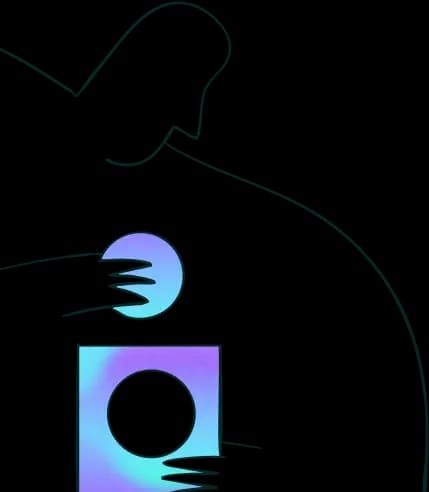

Try for free today
Join over 320,000+ marketers, designers, researchers, and product leaders who use Lyssna to make data-driven decisions.
No credit card required



